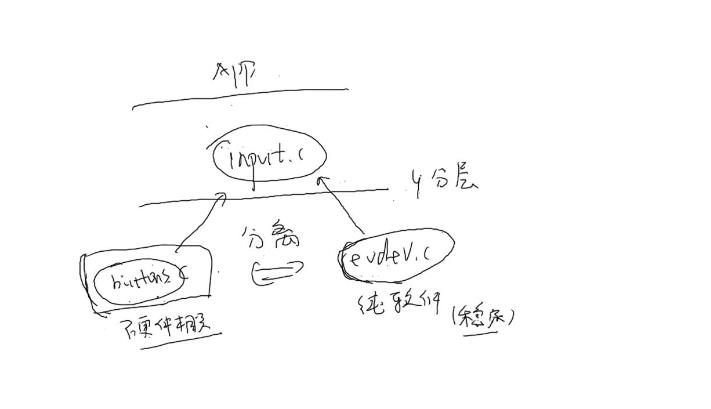驱动程序分层分离概念_总线驱动设备模型_P
Posted 我有一壶酒
tags:
篇首语:本文由小常识网(cha138.com)小编为大家整理,主要介绍了驱动程序分层分离概念_总线驱动设备模型_P相关的知识,希望对你有一定的参考价值。
分层概念:
驱动程序向上注册的原理:
比如:输入子程序一个input.c作为一层,下层为Dev.c和Dir.c,分别编写Dev.c和Dir.c向上Input.c注册;如图所示

分离概念:
分离概念主要是讲,设备驱动程序分成两个部分,也将引进另一个新概念bus_dri_dev模型

总线-驱动-设备模式,是讲吧一个驱动分成两个部分,分别挂载到一条总线上的链表中,总线上有.match函数还对两个链表相同名字相匹配,匹配成功跳到driver驱动程序的probe函数来实现驱动的操作。
一下例子主要编写总线驱动设备模式来实现一个控制LED灯的驱动实验:
led_drv.c
#include <linux/module.h> #include <linux/version.h> #include <linux/init.h> #include <linux/kernel.h> #include <linux/types.h> #include <linux/interrupt.h> #include <linux/list.h> #include <linux/timer.h> #include <linux/init.h> #include <linux/serial_core.h> #include <linux/platform_device.h> /* 分配/设置/注册一个platform_device */ static struct resource led_resource[] = { [0] = { .start = 0x56000050, .end = 0x56000050 + 8 - 1, .flags = IORESOURCE_MEM, }, [1] = { .start = 5, .end = 5, .flags = IORESOURCE_IRQ, } }; static void led_release(struct device * dev) { } static struct platform_device led_dev = { .name = "myled", .id = -1, .num_resources = ARRAY_SIZE(led_resource), .resource = led_resource, .dev = { .release = led_release, }, }; static int led_dev_init(void) { platform_device_register(&led_dev); return 0; } static void led_dev_exit(void) { platform_device_unregister(&led_dev); } module_init(led_dev_init); module_exit(led_dev_exit); MODULE_LICENSE("GPL");
led_dev.c
#include <linux/module.h> #include <linux/version.h> #include <linux/init.h> #include <linux/kernel.h> #include <linux/types.h> #include <linux/interrupt.h> #include <linux/list.h> #include <linux/timer.h> #include <linux/init.h> #include <linux/serial_core.h> #include <linux/platform_device.h> /* 分配/设置/注册一个platform_device */ static struct resource led_resource[] = { [0] = { .start = 0x56000050, .end = 0x56000050 + 8 - 1, .flags = IORESOURCE_MEM, }, [1] = { .start = 5, .end = 5, .flags = IORESOURCE_IRQ, } }; static void led_release(struct device * dev) { } static struct platform_device led_dev = { .name = "myled", .id = -1, .num_resources = ARRAY_SIZE(led_resource), .resource = led_resource, .dev = { .release = led_release, }, }; static int led_dev_init(void) { platform_device_register(&led_dev); return 0; } static void led_dev_exit(void) { platform_device_unregister(&led_dev); } module_init(led_dev_init); module_exit(led_dev_exit); MODULE_LICENSE("GPL");
Makefile:
KERN_DIR = /work/system/linux-2.6.22.6 all: make -C $(KERN_DIR) M=`pwd` modules clean: make -C $(KERN_DIR) M=`pwd` modules clean rm -rf modules.order obj-m += led_drv.o obj-m += led_dev.o
led_test.c
#include <sys/types.h> #include <sys/stat.h> #include <fcntl.h> #include <stdio.h> /* led_test on * led_test off */ int main(int argc, char **argv) { int fd; int val = 1; fd = open("/dev/led", O_RDWR); if (fd < 0) { printf("can\'t open!\\n"); } if (argc != 2) { printf("Usage :\\n"); printf("%s <on|off>\\n", argv[0]); return 0; } if (strcmp(argv[1], "on") == 0) { val = 1; } else { val = 0; } write(fd, &val, 4); return 0; }
以上是关于驱动程序分层分离概念_总线驱动设备模型_P的主要内容,如果未能解决你的问题,请参考以下文章